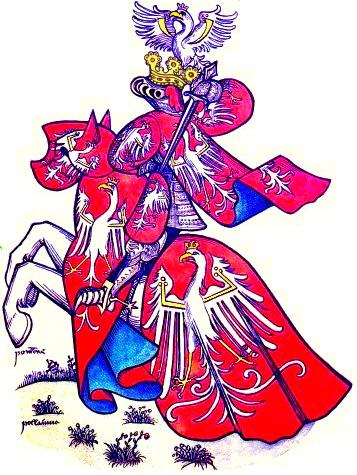The Princely Houses of Poland on:
[Wikipedia]
[Google]
[Amazon]
 The princely houses of Poland and Lithuania differed from other princely houses in Europe. Most importantly,
The princely houses of Poland and Lithuania differed from other princely houses in Europe. Most importantly,
 The princely houses of Poland and Lithuania differed from other princely houses in Europe. Most importantly,
The princely houses of Poland and Lithuania differed from other princely houses in Europe. Most importantly, Polish nobility
The ''szlachta'' (Polish: endonym, Lithuanian: šlėkta) were the noble estate of the realm in the Kingdom of Poland, the Grand Duchy of Lithuania, and the Polish–Lithuanian Commonwealth who, as a class, had the dominating position in ...
(''szlachta'') could not be granted nobility titles
A title is one or more words used before or after a person's name, in certain contexts. It may signify either generation, an official position, or a professional or academic qualification. In some languages, titles may be inserted between the f ...
by the Polish kings
Poland was ruled at various times either by dukes and princes (10th to 14th centuries) or by kings (11th to 18th centuries). During the latter period, a tradition of free election of monarchs made it a uniquely electable position in Europe (16th ...
in the Polish-Lithuanian Commonwealth. Therefore, the title of ''prince
A prince is a male ruler (ranked below a king, grand prince, and grand duke) or a male member of a monarch's or former monarch's family. ''Prince'' is also a title of nobility (often highest), often hereditary, in some European states. ...
'' either dated to the times before the Union of Lublin
The Union of Lublin ( pl, Unia lubelska; lt, Liublino unija) was signed on 1 July 1569 in Lublin, Poland, and created a single state, the Polish–Lithuanian Commonwealth, one of the largest countries in Europe at the time. It replaced the per ...
, which created the Commonwealth in 1569, or was granted to some nobles (usually magnate
The magnate term, from the late Latin ''magnas'', a great man, itself from Latin ''magnus'', "great", means a man from the higher nobility, a man who belongs to the high office-holders, or a man in a high social position, by birth, wealth or ot ...
s) by foreign kings. Due to the longstanding history of common statehood, some noble families often described as "Polish" actually originated in Grand Duchy of Lithuania
The Grand Duchy of Lithuania was a European state that existed from the 13th century to 1795, when the territory was Partitions of Poland, partitioned among the Russian Empire, the Kingdom of Prussia, and the Habsburg Empire, Habsburg Empire of ...
and are of Lithuanian or Ruthenian descent. Some houses are more correctly described as being of Polish-Lithuanian Commonwealth.
Kingdom of Poland
Duchy of Pomerania
Polish–Lithuanian Commonwealth
Old Lithuanian
Gediminid
The House of Gediminid or simply the Gediminids ( lt, Gediminaičiai, sgs, Gedėmėnātē, be, Гедзімінавічы, pl, Giedyminowicze, uk, Гедиміновичі;) were a dynasty of monarchs in the Grand Duchy of Lithuania that rei ...
and Ruthenian (Rurikid) Princely Houses
Princely Houses with
Tatar
The Tatars ()Tatar
in the Collins English Dictionary is an umbrella term for different
origin
These princely houses lived like average rich nobility, but sometimes part of these lived like peasants.http://www.genpol.com/module-subjects-printpage-pageid-37-scope-all.html
* Ahmetowicz
* Achmetowicz
* Adamowicz
* Aksak, Axak
* Apanowicz-Białobłocki
* Assanczukowicz
* Assanowicz
* Bahryński
* Bartoszewicz
* Begimowicz
* Berbasz
* Bierbasz
* Birbasz
* Bohdanowicz
* Bułhak
* Chazbiejewicz
* Dawidowicz
* Fursowicz
* Gliński
* Grocholski
* Haraburda
* Jachicz
* Juchowski
* Jurewicz
* Juszyński
* Kadyszewicz Kejdysz
* Kambułatowicz
* Karaczewicz
* Kasymowicz
* Kieński
* Kiński
* Kordysz
* Korycki
* Korzon
* Kotłubaj
* Kryczyński
* Lebiedziewski
* Lipski
* Łostajski
* Łowczycki
* Malibakszycz
* Maluszycki
* Małyszycki
* Maślakiewicz
* Minbułatowicz
* Najman-Kadyszewicz
* Niekraszewicz
* Nowosielski
* Obulewicz
* Okęcki
* Ostryński
* Petyhorski
* Piotrowski
* Puński
* Rodkiewicz-Szpakowski
* Rudnicki
* Sayna-Kryczyński
* Siehdziński
* Skirmunt
* Smólski
* Sołtan
* Starzyński
* Sulimanowicz
* Sulkiewicz
* Szymkowicz
* Szyryński
* Talkowski
* Tarak-Buczacki
* Taraszewski
* Tuhan-Baranowski
* Ułan
* Ułan-Maluszycki
* Waliła-Łowczycki
* Zawacki
* Zackiewicz-Sulimanowicz
in the Collins English Dictionary is an umbrella term for different
Princely titles granted by foreign monarchs
Kingdom of Poland (Congress Poland)
See also
* List of Polish rulers * List of szlachta * List of Polish titled nobility *Magnates of Poland and Lithuania
The magnates of Poland and Lithuania () were an aristocracy of Polish-Lithuanian nobility ('' szlachta'') that existed in the Crown of the Kingdom of Poland, in the Grand Duchy of Lithuania and, from the 1569 Union of Lublin, in the Polish–Lit ...
References
Further reading
* Konarski S., 1958, Armorial de la noblesse polonaise titrée, Paris. * Kowalski M., 2007, Księstwa w przestrzeni politycznej I Rzeczpospolitej, :I. Kiniorska, S. Sala (red.), Rola geografii społeczno-ekonomicznej w badaniach regionalnych, Instytut Geografii AŚ, PTG, Kielce, 2007, s. 177-186. * Leitgeber S., 1993, Nowy Almanach Błękitny, Oficyna Wydawnicza „Audiutor”, Poznań-Warszawa. * Olszewski H., 1969, Ustrój polityczny Rzeczpospolitej (w:) Tazbir J. (red.), Polska XVII wieku – państwo, społeczeństwo, kultura. Wiedza Powszechna, Warszawa, s. 52-83 * Niesiecki K., Herbarz Polski (Polish Armorial) full title: "Korona Polska przy złotey wolnosci starożytnemi Rycerstwa Polskiego y Wielkiego Xięstwa Litewskiego kleynotami naywyższymi Honorami Heroicznym, Męstwem y odwagą, Wytworną Nauką a naypierwey Cnotą, nauką Pobożnością, y Swiątobliwością ozdobiona Potomnym zaś wiekom na zaszczyt y nieśmiertelną sławę Pamiętnych w tey Oyczyźnie Synow podana TOM ... Przez X. Kaspra Niesieckego Societatis Jesu", Lwów, 1738. ** "Korona Polska..." vol. 1 ** "Korona Polska..." vol. 2 ** "Korona Polska..." vol. 3 ** "Korona Polska..." vol. 4 Edition expanded by other authors: Herbarz Polski... vol. 4-10, published by Jan Nepomucen de Bobrowicz, Leipzig, 1841 * Jasienica P., Myśli o dawnej Polsce, Warszawa: Czytelnik, 1990, {{ISBN, 83-07-01957-5, OCLC 69526168 * Klubówna A., Królowa Jadwiga. Warszawa 1986 * Tęgowski J., Krąg rodzinny Jarosława Bogorii (w:) Genealogia – polska elita polityczna na tle porównawczym, Toruń 1993